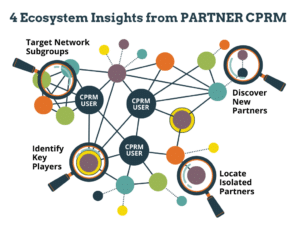The concept of ecosystem thinking and strategies continues to spread among social impact professionals. As such, it’s helpful to revisit the roots of this exciting new way of thinking.
While there are differences between for-profit and non-profit approaches toward ecosystem-building strategies, there are also many lessons we can learn from the first ecosystem engineers. In this article, I reflect on six lessons shared in a recent article about building effective business ecosystems. I detail how they each apply to those working towards social and environmental change. Let’s dig in!
Table of Contents
What is Ecosystem Thinking?

Those who take an ecosystem perspective expand the scope of the problem and its stakeholders to the maximum extent possible, looking for leverage points they can use to shift the overall ecosystem towards more equitable outcomes. This results in more cost-effective solutions that draw on the entire ecosystem’s strengths and resources rather than leaving them siloed from one another.
The Roots of Ecosystem Thinking in the Tech Sector
Ecosystem strategies developed in the tech sector as companies started building complementary products and services that integrate and rely on one another – like apps on the App Store. This new reliance on hierarchal relationships required a shift in thinking about a company and its place in the broader system, including infrastructure, consumers, the economy, and its competitors. This complex environment was often compared to biological ecosystems, and eventually, the phrase ‘ecosystem strategy’ was born.

Get our monthly newsletter with resources for cross-sector collaboration, VNL recommended reading, and upcoming opportunities for engaged in the “network way of working.”
Ecosystem Thinking vs Systems Thinking
The distinction between ecosystem and system thinking is essentially one of scope. Ecosystems refer to the broadest, most comprehensive system at play, which usually includes many nested sub-systems and sub-networks. Ecosystem thinkers look at problems from multiple perspectives and through the lens of different systems to identify how they interact holistically. For example, the issue of homelessness can be analyzed by considering the housing market and development process – or from the perspective of social issues like substance abuse and unemployment – or from the perspective of those experiencing homelessness.
Ecosystem Thinking vs Approach vs Strategy
Ecosystem thinking is a way of thinking that considers each type of system and how they all interact. An ecosystem approach involves building a better ecosystem that changes outcomes due to changing the systems’ interactions. An ecosystem strategy is the way you choose to build or strengthen your ecosystem as part of your approach to maximize your use of your resources given your context, opportunities, and risk.

6 Tips for Building Effective Ecosystems
Ecosystems exist by default – you are embedded in a broader ecosystem no matter what work you do. The key to leveraging an ecosystem strategy is building a better ecosystem that helps you reach your goals. Because of the diffuse way ecosystems are structured, this almost always requires a collaborative approach to overcome the inherent friction involved.
These six lessons, initially written for those building business ecosystems, apply in many similar ways for those thinking about building an effective ecosystem to address health inequity, homelessness, structural racism, climate change, and other complex social issues.
1. Assess complementary sectors to play in.
When taking the first steps to engage with sectors where you haven’t previously engaged, take the time to pick the right one. Some sectors and focus areas are more complementary than others. For example, selecting a partner in a completely different field, like a State Farm Bureau working with a wildlife agency, may lead to innovative ideas but will require more time to get over mistrust, develop a shared language, and identify ways to connect and collaborate. Selecting a sector with more obvious complementary potential can reduce the transaction cost of collaboration and provide a quick win and demonstration of value to propel your work forward.
2. Focus on value for the individual from the start.
One of the most important ecosystem members is the individual experiencing the problem or issue you aim to address. Before you start building an ecosystem to address the situation, understand the individual, their needs, and their context. Otherwise, you may create a robust collaborative community that works together and innovates but still fails to solve the problem – something many of us have experienced before. Talk often to the communities you want to serve, provide meaningful involvement throughout your work, and ask them regularly whether the ecosystem is helping them and, if not, how it could be better.
3. Find the right partners.
Find partners who share the organization’s core principles and mission. Misalignment on foundational elements may cause conflict or confusion later that undermines your impact. Not every organization, community, or individual is ready to take on an ecosystem mindset and collaborate effectively. While striving for broad inclusion, look for the right partners for key roles – especially early on in the process. Putting someone who is disinterested in ecosystem strategies in charge of building the ecosystem is a good way to kill the process right from the start. As your work goes on and your reputation grows, you may be able to involve partners who were initially more unsure or uncertain.
4. Strike balance to govern your ecosystem.
As you start to build new relationships in different sectors and with new partners, you will need to find a way to govern the ecosystem, make decisions, and set goals together collectively. The key is balance: providing enough structure and process to keep things moving while providing enough fluidity and freedom to avoid stifling enthusiasm and energy. Many ecosystem-building efforts use a coalition or network form to organize and govern themselves. For example, consider creating a core working group that sets the agenda and makes day-to-day decisions, with the broader group voting collectively on major decisions and setting goals. Every ecosystem is different and will require its own structures or processes to strike the right balance.
5. Integrate data across your ecosystem for innovation.
Leverage the data that can be collected through ecosystem initiatives and partners. These can reinforce existing operations or can become the foundation for entirely new programs, interventions, and other ways of working together. It is common for a set of partners to come together initially to share information or data, and find they have common goals and unique skills and resources to pool together. Over time, they decide to take action based on the data and insights they have shared and developed together – a concept known in systems thinking as ‘emergence.’ Fostering connections and communication across the ecosystem is the first step to allowing this innovation to emerge.
6. Measure the right impact metrics.
Focusing on traditional KPIs and metrics may not capture the true benefits of ecosystem efforts. For example, some networks form and eventually disband when they show limited impact on the issue they aimed to address. However, their interactions over time led to spillover effects on other tangentially related issues that don’t get identified using traditional evaluation frameworks and measures. Shifts in the ecosystem in one area can cause dramatic, unexpected impacts in other areas – requiring a broader view of what’s happening to measure the complete impact. Where this is impossible, it may be preferable to consider process measures as a proxy for your progress in the field – like the system’s connectivity and change in relationships over time.
PARTNER CPRM: An Ecosystem Data Tracking and Learning Platform for Building Ecosystems that Success

You can identify key nodes and players in the ecosystem, identify redundant ties or isolated partners, track the flow of information and resources through the system, and translate your data into actionable insights to collaborate more effectively. PARTNER provides the ecosystem data you need to succeed.
Get a Taste of PARTNER CPRM – Request a Demo Today!
If you want to explore how PARTNER CPRM can enhance your ecosystem and help you reach your shared goals, we encourage you to request a demo today! See how our platform can leverage network science to generate data-driven strategies today.
Frequently Asked Questions (FAQs)
A: Ecosystem building is a process of fostering and connecting a diverse network of partners, stakeholders, and resources around a common mission or goal. It is a holistic approach that goes beyond the activities of a single organization to create a vibrant, interconnected community of actors. In the context of social impact, this can involve creating a network of nonprofits, businesses, government agencies, and individuals all working towards addressing a shared social issue.
A: Creating a social ecosystem involves several steps. First, it’s essential to clearly define the social mission or issue the ecosystem will address. Second, identify and engage key stakeholders and partners who are committed to this mission. This could include nonprofits, businesses, government entities, funders, and community members. Third, foster open communication, collaboration, and trust among these partners. And finally, regularly evaluate and adapt the ecosystem to respond to changing needs and conditions. It’s a process that requires strategic thinking, inclusiveness, and adaptive leadership.
A: The social change ecosystem refers to a network of individuals, organizations, and institutions working together to create positive social change. This could be addressing issues like poverty, environmental conservation, or social justice. Each member of the ecosystem plays a unique role and brings different skills, perspectives, and resources to the table. The goal is to collaborate and synergize efforts for greater collective impact.
A: An ecosystem map is a visual tool that helps to understand the relationships and dynamics within an ecosystem. It identifies all the key stakeholders, their roles, the interactions between them, and how value flows within the system. In a social change ecosystem, this might include organizations, funders, beneficiaries, influencers, policies, etc. An ecosystem map is a powerful tool for identifying gaps, opportunities, and strategies for strengthening the ecosystem.
A: An ecosystem strategy is a plan of action designed to optimize the health and impact of an ecosystem. It considers the goals of the ecosystem, the roles and needs of its members, and the external environment in which it operates. A good ecosystem strategy is inclusive, flexible, and focused on creating synergies between different actors. It should promote collaboration, align with the shared mission, and ensure that value is equitably distributed among members.
A: Ecosystem thinking organizations need to move away from the traditional siloed approach to problem-solving, where each entity works in isolation. Instead, they should embrace a more holistic and interconnected approach that recognizes the complex interdependencies in our society. This means shifting from a mindset of competition to one of collaboration, from short-term to long-term thinking, and from focusing solely on individual goals to considering the collective good. The move involves embracing diversity, fostering inclusiveness, and promoting shared leadership.






